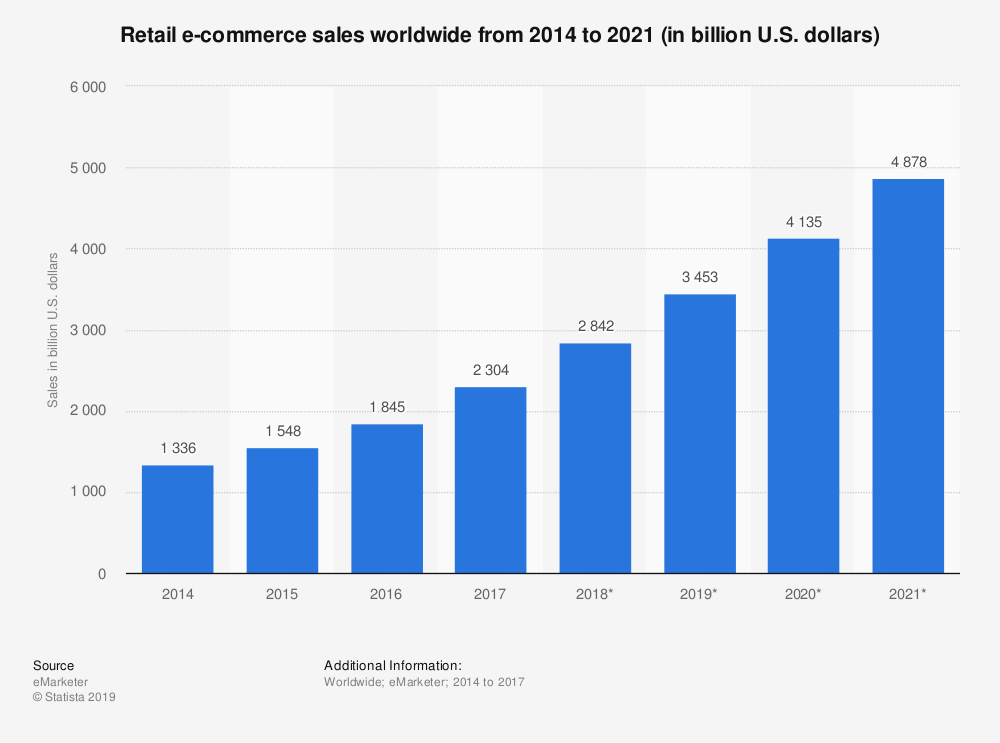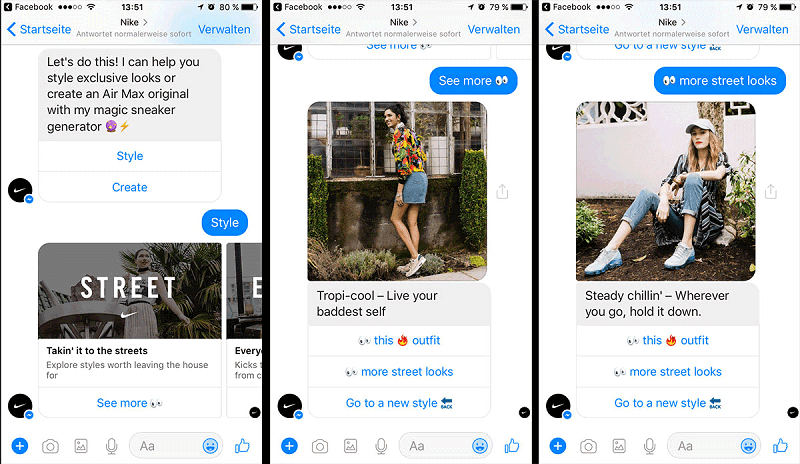How eCommerce uses Machine Learning Applications
Ever since eCommerce became a valid buying option for customers in the late 90s – it continues to rapidly grow with 3.45T in projected sales in 2019.

The online retail industry adopts all sorts of technological innovations, including big data and machine learning, and apply them in various use cases. The proximity of user data and the variety of use cases contributed a lot to bring these technologies to the level they are today.
Now, AI in eCommerce (with marketing ad tech) is one of the leading fields that perfect machine learning algorithms for the benefit of superior customer experience.
Such eCommerce machine learning applications as service personalization, sentiment analysis, image classification, and conversational interfaces (chatbots) getting the first experience in the fields of eCommerce marketplaces.
In this article, we will look at major big data eCommerce artificial intelligence applications and explain how they all improve the flow of business operation.
How to use Machine Learning in eCommerce
1. Product Feed Recommender Engine
Have you ever thought about why Amazon can guess which products may interest you? It is simple. Amazon has a recommender engine that analyses user search results and proposes relevant recommendations
Recommender engines work on user data, the Holy Grail of all sorts of consumer insights in big data eCommerce.
Throughout the numerous sessions of different users, the algorithm gathers the information and clusters patterns. It creates a cohesive picture of what kind of content and products a particular customer segment likes and prefers.
This information is then clustered and classified by machine learning algorithms into a foundation for further recommendations. For example, if the user is looking for calligraphy kits, his query is matched with the similar from the relevant target audience segment.
PREDICTIVE ANALYTICS VS. MACHINE LEARNING: WHAT IS THE DIFFERENCE
From a technical standpoint, the recommender engine is a combination of:
- Clustering unsupervised algorithms;
- Classification supervised algorithms;
- Predictive algorithm for suggestions;
The methodology of the recommender engine is the following:
- Processing user data and extracting preference insights;
- Matching insights with the product (or content overall) database;
- Calculating the probability grid of which kinds of products may be more relevant to a particular user.
As a result, the recommender engine creates an infinite loop in which the user gets content and products that are relatively relevant to its cause and buys even more products. And when the user inputs something new – it is also taken into the equation and subsequently implemented into the recommendation sequence.

This is how Amazon generates 35% of its revenue. Similarly, Best Buy saw an increase of 23,7% after implementing its recommendation system. Currently, recommender engine features are available for custom use on platforms like Shopify and Magento.
If you want to know more about recommender engines – check out this article.
Download free eBook on eCommerce app development
Download now2. Service Personalization / Content Feed Personalization
Automation of the various routines is one of the many benefits of machine learning.
A great example of this is personalization. The machine learning models for eCommerce can adjust the entire marketplace appearance to meet a particular customer.
The primary motivation behind personalization with AI in eCommerce is user engagement that results in a more attractive and practical customer experience (with more conversions and sales). Marketplaces want users to spend more time and made purchases on their platforms. To make it happen, they reshape some aspects of the website to fit the needs of the particular user. The numbers don’t lie – around 48% of customers appreciate when things are adjusted to their preferences and 74% of online shoppers are disappointed if the online store product feed does not provide them with personalized recommendations.
Previously, personalization on eCommerce marketplaces required adapting pages and product selection by the context of the particular page or request without using customer data. Now, a couple of algorithms are handling the personalization process.
DOES YOUR BUSINESS REALLY NEED AN ENTERPRISE ARTIFICIAL INTELLIGENCE
From a technical point of view, service personalization is an expanded application of the recommender engine.
The difference is that instead of slightly adjusting the product feed and related suggestions to the user segment patterns – the entire layout of the marketplace is tailored to the expressed preferences of the particular user.
The key to successful service personalization is seamless implementation into the user experience. In other words, from the user’s side, personalization comes naturally.
The foundation of service personalization is within user data patterns. Everything counts for this kind of customization:
- Product purchases;
- Product filtering (color, size, type, etc.)
- “For later” and “wishlist” listings;
- Product searches and Product views;
- Product rating;
- Blog views;
- Comments, product reviews;
- Interactions with ads;
- Interactions with “you might also like” and “people also buy” sections;
- Even cart abandonment says something about the user;
This information is clustered and classified by a combination of supervised and unsupervised machine learning algorithms and later matched with the website’s database to bring to the forth more relevant stuff.
THE ROLE OF AI AND MACHINE LEARNING IN DIGITAL BIOLOGY
The process includes:
- Personalized product feed;
- Related suggestions;
- Relevant special offers;
- Targeted ads;
Service personalization results in a more focused user experience that avoids possible distractions, cart abandonment, and irrelevant products while emphasizing the stuff that interests the user.
ARTIFICIAL INTELLIGENCE IN ECOMMERCE: THE BEST USAGE AND TOOLS
3. Dynamic Price adjustment – Predictive Analytics
Price adjustment is the field where you can feel the scope of the benefits of machine learning. eCommerce is one of those industries where competition is beyond fierce, especially when it comes to niche consumer segments such as beauty products or hardware. Because of that, it is crucial to get as many advantages as possible to attract and retain customers.
Enter machine learning.
One of the most effective ways of doing that is by offering more competitive prices for the products of interest. This option is made possible by significant big data eCommerce machine learning price monitoring and adjustment. According to the BigCommerce study, price is one of the major drivers for 47% of the customers in eCommerce. So it makes sense to tweak in the right way.
For example, Amazon uses price adjustment based on external trends and product demand and also internal user data (which is also used for product recommendation). This allows them to subtly make the prices for the products more appealing to the customers interested in them.

Let’s look at another example, Walmart uses price adjustment for customer retention. Their system is all about monitoring the competition and making their own prices look lower in comparison.
Here’s how the price adjustment system works:

- There are three key sources of information:
- Marketplace data itself;
- General user trends and demands;
- A network of competing marketplaces with the related products and target audience segments.
- There are regular checks of the prices for the products on the competing marketplaces. The comparison of this information with the prices on your marketplace.
- Then this information is combined with general user trends and demands.
- Then the predictive algorithm calculates the best possible price change for the particular target audience segment.
In addition to the straightforward competition, the price adjustment is often used to decrease customer churn on a particular online retail shop.
In this case, the method is more straightforward – it includes the price for the product and user trends. The result is more attractive prices for low demand products that cause the renewal of the customer interest.
TOP AI USE CASES IN SUPPLY CHAIN OPTIMIZATION
4. Supply and Demand Prediction Using Machine Learning
Supply and demand prediction is the evolution of price adjustment combined with the recommender engine. There are various products the interest for which spikes at a specific time, and this is a perfect reason to take advantage of it. According to Statista, the 2017 winter holidays generated over 8.2 billion worth of eCommerce sales in the United States.
The challenge comes with the management of the product inventory. It is essential to retain smooth processes when the trend is at the peak. The main problems of supply and demand are:
- Lack of products that satisfy the specific demand;
- Insufficient quantity of the products that meet the particular demand.
As a result, companies are losing up to 25% of the monthly revenue due to unpredictable spikes of demands and lacking availability of the product.
Predictive machine learning algorithms solve both problems. Here’s how it works:
The reaction to product demand variation adds the world outside to the equation. There are general trends and patterns of product demands available in public sources (Google Trends, etc.).
Then there are internal stats of product demand and customer purchase patterns.
This information is combined and laid out on the product inventory. You can see which product supply needs a boost and which products are lacking.
With this information, you can optimize the process and deliver a satisfying customer experience.
BEST USE CASES OF ARTIFICIAL INTELLIGENCE IN THE TRANSPORTATION INDUSTRY
There are two significant types of product demand – seasonal and incidental.
- Seasonal demand – like Christmas-related products around Christmas. In this case, you can predict supply and demand prediction in hindsight and then optimize it on the spot.
- Incidental demand – Chernobyl-related content because of HBO Mini-series. Barnes and Noble used the interest spike to promote books on radiation-related topics with a revenue increase of up to 15%.
As a result, with the assistance of machine learning, the eCommerce marketplace can easily manage a system of discounts for specific products to satisfy the product demand and attract more customers with more reasonable prices.
5. Machine Learning for Visual Search
Visual search and image recognition technology had greatly benefitted from the adoption of mobile eCommerce shopping. The reason for its growing popularity is simple.
Unlike alphanumeric search engines that require specific information to deliver the desired result – all you need for a coherent visual search is an image of a thing the user is searching for. Everything else is handled by an image recognition engine that matches input information with the product database and selects the closest matches.
Visual search streamlines customer journey towards the purchase, especially for the clothes and make-up segment. For example, Beauty.com had increased its sales by 15% since implementing visual search features.

Here’s how it works:
- There is an image recognition algorithm at play. It is used to define an image and describe its surface features. Usually, the process involves a convolutional neural network to recognize an image and a recurrent neural network to describe an image further.
- Then the image description is combined with the product information.
- When the search engine processes the image input – it matches the image descriptions and goes to the product information related to it.
These days, there are two significant proponents of visual search commerce – Amazon and Pinterest.
While Amazon is using visual search as an additional feature to the core search engine, Pinterest is using it as a core feature with the image coming before the product information. This approach embraces more natural product discovery and as a result, more engaging use of the application.
6. Fraud Detection and Prevention Opportunities for eCommerce
Fraud is one of the eCommerce’s biggest banes. Just last year the eCommerce industry had lost more than billions on various fraud schemes. It is one of the problems that never really goes away – you can find a way to eliminate present threats, and later it will adapt and come back with the new bag of tricks.
Hopefully, with an adoption of AI in eCommerce and implementation of specialized Machine Learning algorithms – predictive analytics are capable of detecting suspicious activity and preventing it from causing damage.
Let’s look at how eCommerce machine learning algorithms handle main fraud threats:
- Return to Origin fraud. This fraud is an abuse of refund policy. In this case, the fraud detection algorithm analyzes user activity and its patterns and compares it with the frequent cases of refund. Insufficient periods between order and refund usually, expose this trick.
- Promo Code Abuse – when scammers create multiple accounts and apply the promo code on orders. In this case, there is anomaly detection and signal source analysis. Usually, this type of scam is performed by low-level criminals without intricate networks of the cover-up. Because of that, similar IP addresses expose this type of fraud. In other cases, promo code abusers are exposed by their behavioral patterns.
- Account Takeover. It is one of the more sophisticated types of eCommerce fraud. In this case, external phishing techniques gain access to the user account. The most common method is by installing malware through malicious links. Then fraudster takes over the account and performs purchases as he pleases. Anomaly detection algorithm combined with behavioral patterns combined with additional stages of identity verification (including location, IP, device, etc.) are used to expose and prevent this from happening.
7. Chatbots and conversational interfaces
Chatbots are all the rage right now. In a couple of years, chatbots had managed to evolve from the clumsy ELIZA-styled fancy interfaces to the competent multi-purpose assistants that cover everything from customer support to lead generation.
With the wide adoption of smartphones and voice-control, the implementation of conversational interfaces to the big data eCommerce marketplaces became a necessity. The key benefits of implementing a conversational interface to the eCommerce store are functional versatility and streamlining of the finding and purchasing of products. In a way, a conversational UI chatbot is the ultimate customer service application.
The bot can help the user to:
- Find or suggest relevant products;
- Compare the qualities of the products;
- Proceed with the payments;
- Arrange shopping lists.
At its core, eCommerce machine learning conversational UI use speech recognition algorithms and semantic search natural language processing algorithms.
- First, the transcription of the input speech happens. In the case of textual input – it is processed directly.
- Then the transcribed text is processed and deconstructed to critical elements. Topic modeling, named-entity recognition, and intent analysis algorithms are applied.
- This process lays the groundwork for determining the request.
- Then the algorithm uses available input information and semantic search to find matching credentials in the internal database. The results are arranged by probability and delivered as output.
If the information is insufficient – a chatbot can ask additional questions regarding aspects of the product or the nature of the query. For example, Nike is using chatbots to simplify finding a fitting product (mixed with special offers and discounts).

On the other hand, Lego is using a chatbot to make relevant suggestions on gifts.

If you want to read more about conversational UI – check out this article.
Want to Learn More About The APP Solutions Approaches In Project Development?
Download Free EbookConclusion
AI and machine learning for eCommerce seems to be a perfect combination in which both parties benefit from being with each other.
The role of artificial intelligence in eCommerce is to make the buyers’ journey more comfortable and more efficient with various machine learning algorithms.
eCommerce is an industry where applications of machine learning directly contribute to the quality of the customer experience and business growth.
Are you ready to apply machine learning in your online store? Fill in the contact form, and we will get in touch.
Want to receive reading suggestions once a month?
Subscribe to our newsletters